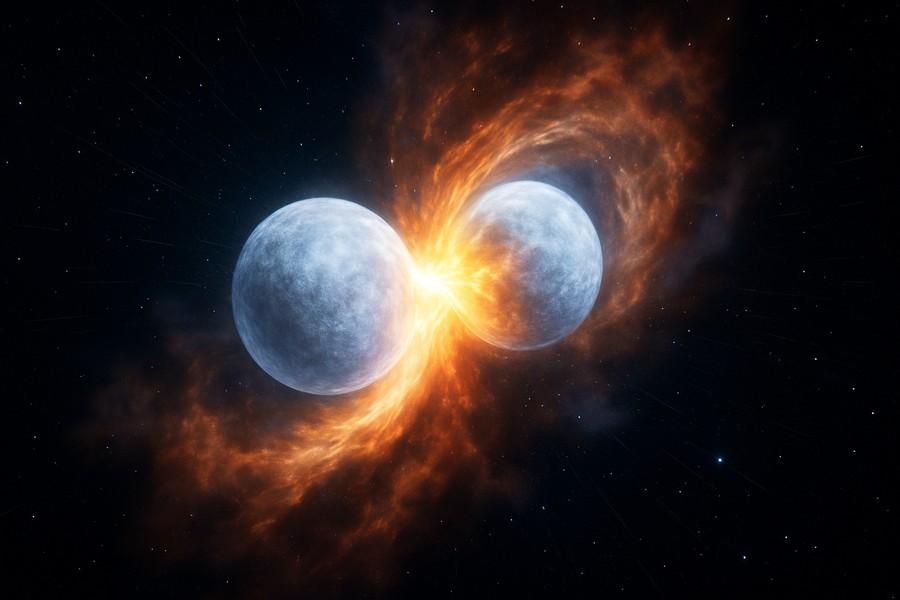
Revelations from Simulations: Neutron Star Mergers and Particle Transformations
Imagine two incredibly dense objects, remains of once-glorious stars, colliding together. This event, a neutron star merger, is one of the most potent occurrences in the cosmos, creating signals that we can observe from our planet.
A Deep Dive into Neutrinos
New simulations have been developed that shed light on how these cosmic collisions evolve. The simulations show that minute particles known as neutrinos, which can travel vast distances without being disturbed, play a significant role in the unfolding of these mergers. These discoveries could help us understand where metals and rare earth elements come from, and how physics operates in extreme conditions.
The recent study is the first to simulate how neutrinos can transform or "change flavors" in the heart of a neutron star merger. Neutrinos are tiny particles that interact weakly with other matter, and they come in three variations or "flavors": electron, muon, and tau. Under certain conditions, like inside a neutron star, neutrinos can hypothetically change flavors, which alters the kind of particles they interact with.
Implications of Neutrino Transformation
Earlier simulations of neutron star mergers did not include the transformation of neutrino flavor. This was partly due to the difficulty in capturing the process, which happens incredibly quickly, and partly due to a lack of knowledge about the theoretical physics underlying these transformations.
But new simulations have found that the extent and location of neutrino mixing can influence the matter ejected from the merger, the composition and structure of what remains after the merger—the remnant—as well as the surrounding material.
Researchers built a computer simulation of a neutron star merger from scratch, incorporating numerous physical processes, including gravity, general relativity, hydrodynamics, and neutrino mixing. They also accounted for the transformation of electron flavor neutrinos to muon flavor, which is the most relevant neutrino transformation in this environment. They modeled several scenarios, varying the timing and location of the mixing as well as the density of the surrounding material.
Neutrino Mixing and Element Creation
The research found that all these factors influenced the composition and structure of the merger remnant, including the type and quantities of elements created during the merger. In a collision, the neutrons in a neutron star can be hurled at other atoms in the debris, which can capture the neutrons and ultimately decay into heavier elements, such as precious metals like gold and platinum, as well as rare earth elements used in smartphones, electric vehicle batteries, and other devices.
Changes in neutrino flavor can alter how many neutrons are available, which directly impacts the creation of heavy metals and rare earth elements. Accounting for neutrino mixing could increase element production by as much as ten times.
Impact on Observable Emissions
Neutrino mixing during the merger also impacts the amount and composition of matter ejected from the merger, which could alter the emissions detectable from Earth. These emissions usually include gravitational waves—ripples in space-time—as well as electromagnetic radiation like X-rays or gamma rays.
With advanced detectors, astronomers are geared to detect gravitational waves more frequently than before. This improved understanding of how these emissions are created from neutron star mergers will help us interpret future observations better.
Future of Neutrino Mixing Simulations
Researchers likened modeling the mixing processes to an upside-down pendulum. Initially, many changes occur rapidly, but eventually, the pendulum settles into a stable equilibrium. However, much is still unknown about the theoretical physics of these neutrino transformations.
As theoretical particle physics continues to evolve, simulations can be greatly improved. Current understanding suggests that these transformations are very likely, and if they occur, they can have major effects. Therefore, it's crucial to include them in future models and analyses.
With the infrastructure for these complex simulations now in place, other groups are expected to use the technology to further explore the impacts of neutrino mixing.
"Neutron star mergers function like cosmic laboratories, providing crucial insights into extreme physics that we can't replicate safely on Earth," one of the researchers commented.
